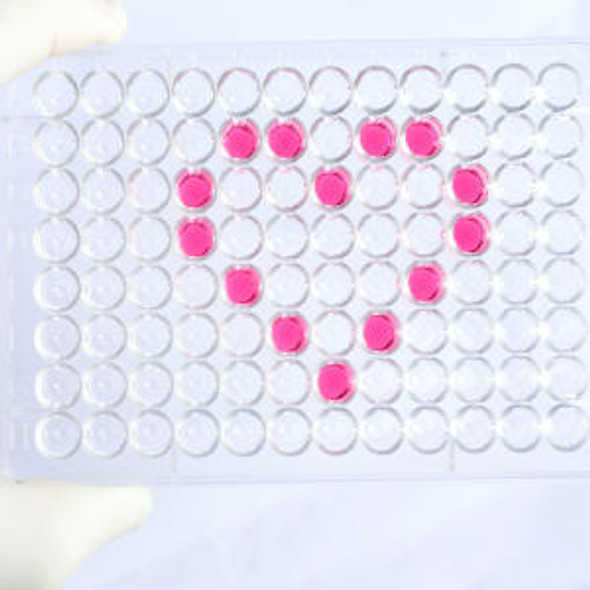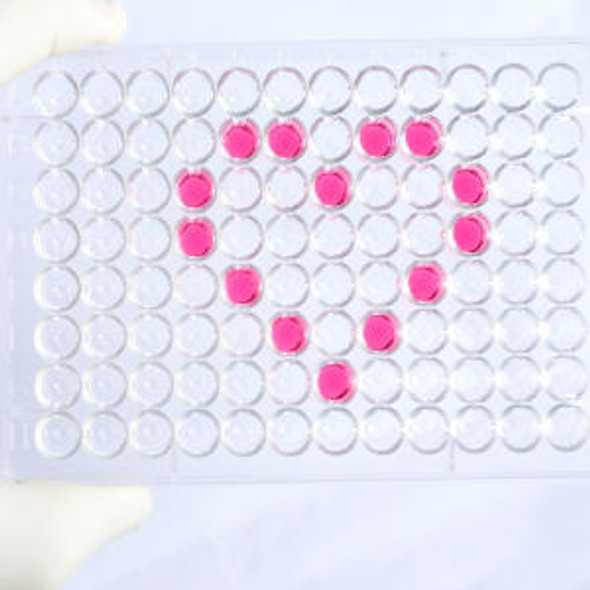Description
Human PINK1 (Serine/threonine-protein kinase PINK1, mitochondrial) ELISA
PINK1 (PTEN Induced Kinase 1) encoded protein is a tumor suppressor and a regulator of the phosphatidylinositol 3-kinase (PI3K) signaling pathway. Mutations in PINK1 have been associated with cases of breast cancer, glioblastoma, and prostate cancer. Diseases associated with PINK1 include Parkinson Disease 6, Autosomal Recessive Early-Onset and Parkinson Disease 2, Autosomal Recessive Juvenile. Among PINK1 gene related pathways are Parkinsons Disease Pathway and Neuroscience.
| Product Name: | Human PINK1 (Serine/threonine-protein kinase PINK1, mitochondrial) ELISA Kit |
| Product Code: | HUFI04932 |
| Size: | 96 Assays |
| Alias: | PINK1 ELISA Kit |
| Detection method: | Sandwich ELISA, Double Antibody |
| Application: | This immunoassay kit allows for the in vitro quantitative determination of Human PINK1 (Serine/threonine-protein kinase PINK1, mitochondrial) concentrations in serum plasma and other biological fluids. |
| Sensitivity: | < 0.094ng/ml |
| Range: | 0.156-10ng/ml |
| Storage: | 4°C for 6 months |
| Note: | For Research Use Only |
| Recovery: | Matrices listed below were spiked with certain level of Human PINK1 (Serine/threonine-protein kinase PINK1, mitochondrial) and the recovery rates were calculated by comparing the measured value to the expected amount of Human PINK1 (Serine/threonine-protein kinase PINK1, mitochondrial) in samples. Enquire for more information. |
| Linearity: | The linearity of the kit was assayed by testing samples spiked with appropriate concentration of Human PINK1 (Serine/threonine-protein kinase PINK1, mitochondrial) and their serial dilutions. The results were demonstrated by the percentage of calculated concentration to the expected. Enquire for more information. |
| CV(%): | Intra-Assay: CV<8% Inter-Assay: CV<10% |
| Component | Quantity | Storage |
| ELISA Microplate (Dismountable) | 8×12 strips | 4°C for 6 months |
| Lyophilized Standard | 2 | 4°C/-20°C |
| Sample/Standard Dilution Buffer | 20ml | 4°C |
| Biotin-labeled Antibody(Concentrated) | 120ul | 4°C (Protect from light) |
| Antibody Dilution Buffer | 10ml | 4°C |
| HRP-Streptavidin Conjugate(SABC) | 120ul | 4°C (Protect from light) |
| SABC Dilution Buffer | 10ml | 4°C |
| TMB Substrate | 10ml | 4°C (Protect from light) |
| Stop Solution | 10ml | 4°C |
| Wash Buffer(25X) | 30ml | 4°C |
| Plate Sealer | 5 | - |
Other materials and equipment required:
- Microplate reader with 450 nm wavelength filter
- Multichannel Pipette, Pipette, microcentrifuge tubes and disposable pipette tips
- Incubator
- Deionized or distilled water
- Absorbent paper
- Buffer resevoir
| UniProt Protein Function: | PINK1: Protects against mitochondrial dysfunction during cellular stress, potentially by phosphorylating mitochondrial proteins. Involved in the clearance of damaged mitochondria via selective autophagy (mitophagy). It is necessary for PARK2 recruitment to dysfunctional mitochondria to initiate their degradation. Interats with PARK2. Highly expressed in heart, skeletal muscle and testis, and at lower levels in brain, placenta, liver, kidney, pancreas, prostate, ovary and small intestine. Present in the embryonic testis from an early stage of development. Belongs to the protein kinase superfamily. Ser/Thr protein kinase family. 2 isoforms of the human protein are produced by alternative splicing. |
| UniProt Protein Details: | Protein type:Membrane protein, integral; Protein kinase, Other; Kinase, protein; Mitochondrial; EC 2.7.11.1; Protein kinase, Ser/Thr (non-receptor); Other group; NKF2 family Chromosomal Location of Human Ortholog: 1p36 Cellular Component: mitochondrion; mitochondrial intermembrane space; cytosol; mitochondrial outer membrane; cytoskeleton; membrane; axon; perinuclear region of cytoplasm; mitochondrial inner membrane; cytoplasm; TORC2 complex; chromatin; nucleus; integral to mitochondrial outer membrane Molecular Function:protein kinase B binding; protein serine/threonine kinase activity; protein binding; protease activator activity; protease binding; ubiquitin protein ligase binding; magnesium ion binding; kinase activity; ATP binding Biological Process: ubiquitin-dependent protein catabolic process; negative regulation of JNK cascade; positive regulation of dopamine secretion; positive regulation of translation; regulation of protein ubiquitination; protein ubiquitination; protein amino acid phosphorylation; positive regulation of protein amino acid dephosphorylation; negative regulation of macroautophagy; regulation of mitochondrial membrane potential; positive regulation of ubiquitin-protein ligase activity; regulation of protein complex assembly; response to stress; negative regulation of neuron apoptosis; regulation of hydrogen peroxide metabolic process; mitochondrion organization and biogenesis; positive regulation of I-kappaB kinase/NF-kappaB cascade; protein stabilization; activation of protein kinase B; positive regulation of synaptic transmission, dopaminergic; positive regulation of peptidyl-serine phosphorylation; positive regulation of protein kinase B signaling cascade; peptidyl-serine phosphorylation; mitochondrion degradation; positive regulation of transcription factor activity; response to oxidative stress; positive regulation of protein amino acid phosphorylation; phosphorylation Disease: Parkinson Disease 6, Autosomal Recessive Early-onset |
| NCBI Summary: | This gene encodes a serine/threonine protein kinase that localizes to mitochondria. It is thought to protect cells from stress-induced mitochondrial dysfunction. Mutations in this gene cause one form of autosomal recessive early-onset Parkinson disease. [provided by RefSeq, Jul 2008] |
| UniProt Code: | Q9BXM7 |
| NCBI GenInfo Identifier: | 14165272 |
| NCBI Gene ID: | 65018 |
| NCBI Accession: | NP_115785.1 |
| UniProt Secondary Accession: | Q9BXM7,Q8N6T9, Q8NBU3, Q96DE4, |
| UniProt Related Accession: | Q9BXM7 |
| Molecular Weight: | |
| NCBI Full Name: | serine/threonine-protein kinase PINK1, mitochondrial |
| NCBI Synonym Full Names: | PTEN induced putative kinase 1 |
| NCBI Official Symbol: | PINK1 |
| NCBI Official Synonym Symbols: | BRPK; PARK6 |
| NCBI Protein Information: | serine/threonine-protein kinase PINK1, mitochondrial; protein kinase BRPK; PTEN-induced putative kinase protein 1 |
| UniProt Protein Name: | Serine/threonine-protein kinase PINK1, mitochondrial |
| UniProt Synonym Protein Names: | BRPK; PTEN-induced putative kinase protein 1 |
| Protein Family: | Serine/threonine-protein kinase |
| UniProt Gene Name: | PINK1 |
| UniProt Entry Name: | PINK1_HUMAN |
*Note: Protocols are specific to each batch/lot. For the correct instructions please follow the protocol included in your kit.
Before adding to wells, equilibrate the SABC working solution and TMB substrate for at least 30 min at 37 °C. When diluting samples and reagents, they must be mixed completely and evenly. It is recommended to plot a standard curve for each test.
| Step | Protocol |
| 1. | Set standard, test sample and control (zero) wells on the pre-coated plate respectively, and then, record their positions. It is recommended to measure each standard and sample in duplicate. Wash plate 2 times before adding standard, sample and control (zero) wells! |
| 2. | Aliquot 0.1ml standard solutions into the standard wells. |
| 3. | Add 0.1 ml of Sample / Standard dilution buffer into the control (zero) well. |
| 4. | Add 0.1 ml of properly diluted sample ( Human serum, plasma, tissue homogenates and other biological fluids.) into test sample wells. |
| 5. | Seal the plate with a cover and incubate at 37 °C for 90 min. |
| 6. | Remove the cover and discard the plate content, clap the plate on the absorbent filter papers or other absorbent material. Do NOT let the wells completely dry at any time. Wash plate X2. |
| 7. | Add 0.1 ml of Biotin- detection antibody working solution into the above wells (standard, test sample & zero wells). Add the solution at the bottom of each well without touching the side wall. |
| 8. | Seal the plate with a cover and incubate at 37 °C for 60 min. |
| 9. | Remove the cover, and wash plate 3 times with Wash buffer. Let wash buffer rest in wells for 1 min between each wash. |
| 10. | Add 0.1 ml of SABC working solution into each well, cover the plate and incubate at 37 °C for 30 min. |
| 11. | Remove the cover and wash plate 5 times with Wash buffer, and each time let the wash buffer stay in the wells for 1-2 min. |
| 12. | Add 90 µL of TMB substrate into each well, cover the plate and incubate at 37 °C in dark within 10-20 min. (Note: This incubation time is for reference use only, the optimal time should be determined by end user.) And the shades of blue can be seen in the first 3-4 wells (with most concentrated standard solutions), the other wells show no obvious color. |
| 13. | Add 50 µL of Stop solution into each well and mix thoroughly. The color changes into yellow immediately. |
| 14. | Read the O.D. absorbance at 450 nm in a microplate reader immediately after adding the stop solution. |
When carrying out an ELISA assay it is important to prepare your samples in order to achieve the best possible results. Below we have a list of procedures for the preparation of samples for different sample types.
| Sample Type | Protocol |
| Serum | If using serum separator tubes, allow samples to clot for 30 minutes at room temperature. Centrifuge for 10 minutes at 1,000x g. Collect the serum fraction and assay promptly or aliquot and store the samples at -80°C. Avoid multiple freeze-thaw cycles. If serum separator tubes are not being used, allow samples to clot overnight at 2-8°C. Centrifuge for 10 minutes at 1,000x g. Remove serum and assay promptly or aliquot and store the samples at -80°C. Avoid multiple freeze-thaw cycles. |
| Plasma | Collect plasma using EDTA or heparin as an anticoagulant. Centrifuge samples at 4°C for 15 mins at 1000 × g within 30 mins of collection. Collect the plasma fraction and assay promptly or aliquot and store the samples at -80°C. Avoid multiple freeze-thaw cycles. Note: Over haemolysed samples are not suitable for use with this kit. |
| Urine & Cerebrospinal Fluid | Collect the urine (mid-stream) in a sterile container, centrifuge for 20 mins at 2000-3000 rpm. Remove supernatant and assay immediately. If any precipitation is detected, repeat the centrifugation step. A similar protocol can be used for cerebrospinal fluid. |
| Cell culture supernatant | Collect the cell culture media by pipette, followed by centrifugation at 4°C for 20 mins at 1500 rpm. Collect the clear supernatant and assay immediately. |
| Cell lysates | Solubilize cells in lysis buffer and allow to sit on ice for 30 minutes. Centrifuge tubes at 14,000 x g for 5 minutes to remove insoluble material. Aliquot the supernatant into a new tube and discard the remaining whole cell extract. Quantify total protein concentration using a total protein assay. Assay immediately or aliquot and store at ≤ -20 °C. |
| Tissue homogenates | The preparation of tissue homogenates will vary depending upon tissue type. Rinse tissue with 1X PBS to remove excess blood & homogenize in 20ml of 1X PBS (including protease inhibitors) and store overnight at ≤ -20°C. Two freeze-thaw cycles are required to break the cell membranes. To further disrupt the cell membranes you can sonicate the samples. Centrifuge homogenates for 5 mins at 5000xg. Remove the supernatant and assay immediately or aliquot and store at -20°C or -80°C. |
| Tissue lysates | Rinse tissue with PBS, cut into 1-2 mm pieces, and homogenize with a tissue homogenizer in PBS. Add an equal volume of RIPA buffer containing protease inhibitors and lyse tissues at room temperature for 30 minutes with gentle agitation. Centrifuge to remove debris. Quantify total protein concentration using a total protein assay. Assay immediately or aliquot and store at ≤ -20 °C. |
| Breast Milk | Collect milk samples and centrifuge at 10,000 x g for 60 min at 4°C. Aliquot the supernatant and assay. For long term use, store samples at -80°C. Minimize freeze/thaw cycles. |
Fill out our quote form below and a dedicated member of staff will get back to you within one working day!






